As I stood in front of the mirror, I saw the stubborn lower belly fat. It seemed to cling on, no matter how hard I tried. I knew it was time for a change.
Losing the extra inches around my waist was my goal. But it seemed like an elusive dream. Then, I found a 30-day diet plan that promised to help.
This plan wasn’t about quick fixes or crash diets. It was a holistic approach based on the latest research. I was determined to try it, and the results were amazing.
In the next sections, I’ll share the secrets of this 30-day diet plan. It helped me conquer my lower belly fat and feel confident in my skin. We’ll cover belly fat types, health risks, and how to reduce fat sustainably.
Understanding Belly Fat Types and Health Risks
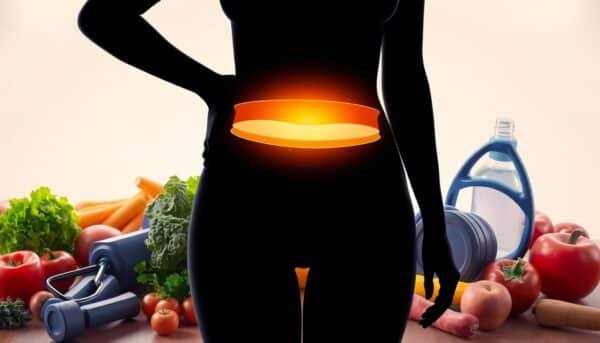
Belly fat is a big worry for many. It’s key to know the different fats in this area. Subcutaneous fat is under the skin, while visceral fat is around organs. Visceral fat is more dangerous.
Subcutaneous vs Visceral Fat
Subcutaneous fat is what you can pinch under your skin. It’s visible and less risky than visceral fat. Visceral fat, however, is around organs and linked to health issues.
Impact on Chronic Conditions
Too much visceral fat is bad for your health. It raises risks of high blood pressure, diabetes, heart disease, and some cancers. Knowing the difference helps in losing weight effectively.
Body Composition Basics
Body Mass Index (BMI) doesn’t show body fat distribution. You can have a normal BMI but still have too much visceral fat. So, focus on body composition, not just weight, for ab workouts for men and ab workouts for women.
Creating Your Sustainable 30-Day Weight Loss Strategy
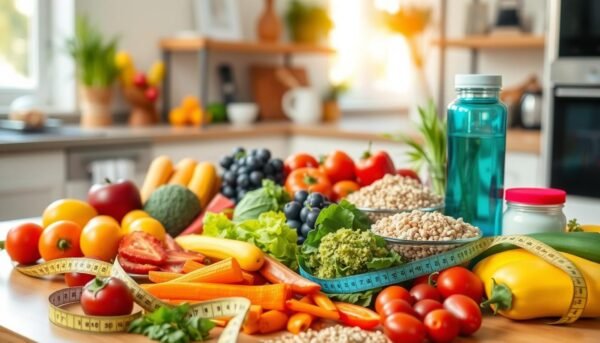
For lasting weight loss, you need a plan that fits your life. Start your 30-day journey with a calorie deficit plan. This includes eating less and exercising more. Safe weight loss is about 1-2 pounds (0.45-1 kg) each week.
Many things can affect how well you lose weight. These include your weight, lifestyle, genes, sleep, age, and workout type. Make your plan fit you and your goals. A mix of cardio and strength training works best for keeping weight off.
- Aim for a calorie deficit of 500-1,000 calories per day to achieve the recommended 1-2 pounds of weight loss per week.
- Combine cardiovascular activities, such as brisk walking, jogging, or cycling, with resistance training exercises to boost your metabolism and tone your muscles.
- Prioritize getting 7-9 hours of quality sleep each night, as adequate rest is crucial for weight management and overall health.
- Stay hydrated by drinking plenty of water throughout the day, which can help support your weight loss efforts.
Make a 30-day plan that meets your needs and likes. This way, you’ll reach your goals and keep a healthy weight for good.
How to Lose Lower Belly Fat Through Diet Modifications

Getting rid of lower belly fat needs smart diet changes. You must eat fewer calories than your body burns. Choosing the right foods and timing your meals can help target that hard-to-lose belly fat.
Calorie Deficit Fundamentals
To lose lower belly fat, you need a calorie deficit. This means eating less than your body needs to stay the same weight. A 500-1000 calorie daily deficit can lead to losing 1-2 pounds a week. This is a healthy and steady weight loss pace.
Macro Distribution for Fat Loss
It’s important to balance your macronutrients (protein, carbs, and fat) for losing lower belly fat. Eat more protein, moderate carbs, and include healthy fats. This balance helps keep muscle while losing fat, especially around the belly.
Meal Timing Strategies
When you eat can affect your belly fat loss. Intermittent fasting or eating smaller meals can help keep a calorie deficit. It also controls hunger and blood sugar. Try different meal times to see what fits your life best.
Remember, a good diet for belly fat reduction is about small, steady changes. Focus on whole foods and drink plenty of water. This helps you feel full and lose that hard-to-lose lower belly fat.
Essential Nutrients That Target Abdominal Fat
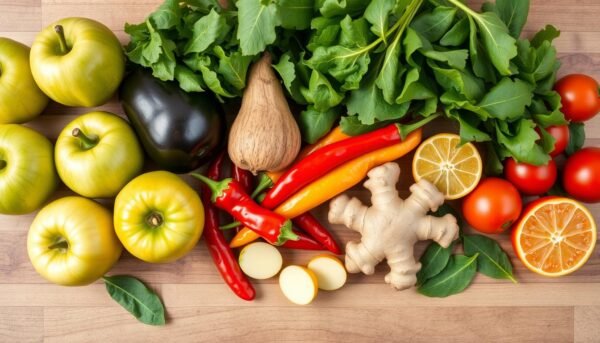
Shedding lower belly fat is easier with the right nutrients. Adding metabolism boosters and belly fat-reducing foods to your diet helps. This way, you can lose weight and get a slimmer midsection.
Soluble fiber is a big help against belly fat. It absorbs water and slows down digestion, making you feel full. Studies show that low-carb diets can lead to a smaller waist in just five years.
Probiotics in foods like yogurt also help. They can cut down belly fat. Research shows a 4% body fat reduction in just six weeks.
Omega-3 fatty acids in fatty fish like salmon are anti-inflammatory. Eating two to three servings a week can reduce dangerous belly fat.
- Apple cider vinegar, which can help flush out toxins and cleanse the liver when consumed in the morning
- Whole grains, which have been linked to more fat loss in the stomach compared to processed grains
- The Mediterranean diet, which has been shown to aid in weight loss, improve blood glucose control, and reduce the risk of various health conditions
By focusing on these nutrients, you can get a slimmer, healthier midsection. Add them to your diet for belly fat reduction.
Power of Protein in Belly Fat Reduction
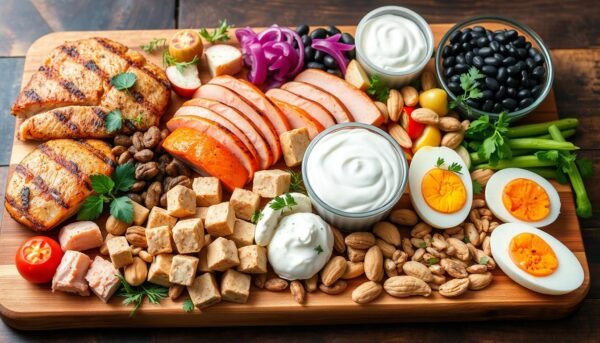
If you want to lose lower belly fat, add more protein to your diet. Protein helps boost your metabolism and reduces hunger. It also keeps your muscles strong while you lose weight.
Recommended Protein Sources
To get the most from protein for belly fat loss, eat a variety of high-quality proteins. Good choices include:
- Lean meats: chicken breast, turkey, and lean cuts of beef
- Fish: salmon, mackerel, and sardines
- Eggs
- Dairy products: Greek yogurt, cottage cheese
- Plant-based options: beans, lentils, tofu, and tempeh
- Protein supplements: whey protein powder
Daily Protein Requirements
The right amount of protein varies by person. Aim for 1.6 to 2.2 grams of protein per kilogram of body weight. For a 150-pound (68 kg) person, that’s 109-150 grams of protein daily.
Protein Timing for Maximum Benefits
Timing your protein intake is key for fat loss and muscle preservation. Eat protein around workouts and spread it out throughout the day. This boosts your metabolism and body shape.
By eating more high-quality proteins and timing them right, you can lose lower belly fat and boost your metabolism. This leads to long-term success.
Smart Carbohydrate Choices for Fat Loss
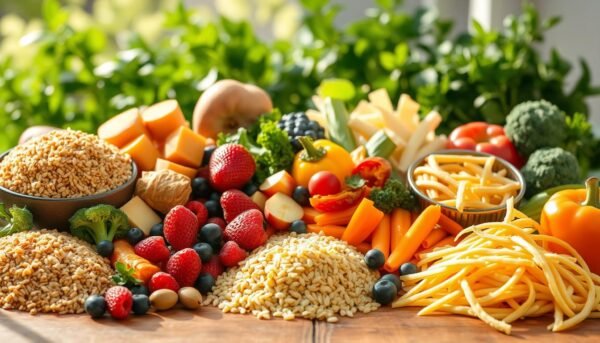
Smart carbs are key for losing belly fat and weight. Choose complex carbs with a low glycemic index. They give you steady energy and help control blood sugar.
Whole grains, legumes, and veggies are great choices. They’re full of nutrients like fiber, vitamins, and minerals. Avoid refined carbs and added sugars to prevent belly fat.
The Framingham Heart Study found a link. People who ate more whole grains had 17% less belly fat. This shows why choosing smart carbs is important.
| Carbohydrate Type | Recommended Intake | Benefits for Fat Loss |
|---|---|---|
| Complex Carbohydrates (Whole Grains, Legumes, Vegetables) | 40-60% of total daily calories | Sustained energy, blood sugar control, high in fiber and nutrients |
| Refined Carbohydrates (Added Sugars, Refined Grains) | Limit to less than 10% of total daily calories | Can contribute to belly fat gain, low in nutrients |
Choosing smart carbs helps you lose belly fat and reach your weight loss goals. Focus on complex carbs and cut down on refined carbs for a healthier diet.
The Role of Fiber in Reducing Belly Fat

Fiber is key for a flat stomach and less belly fat. It’s important for health and helps with weight loss. Knowing about soluble and insoluble fiber helps us use fiber to fight belly fat.
Soluble vs Insoluble Fiber
Soluble fiber, found in beans, oats, and flaxseeds, turns into a gel in your stomach. This slows down how nutrients are absorbed. It makes you feel full and helps control blood sugar.
Insoluble fiber, on the other hand, makes your stool bulkier. It keeps your bowels regular and supports digestion.
Studies show eating more soluble fiber can reduce belly fat by 3.7% over 5 years. This highlights the need for fiber-rich foods in a diet to lose belly fat.
Top Fiber-Rich Foods
To get a flatter stomach, eat more of these fiber-rich foods:
- Fruits (e.g., berries, apples, pears)
- Vegetables (e.g., broccoli, Brussels sprouts, artichokes)
- Legumes (e.g., lentils, black beans, chickpeas)
- Whole grains (e.g., oats, quinoa, brown rice)
- Nuts and seeds (e.g., chia seeds, flaxseeds, almonds)
Try to eat 25-38 grams of fiber daily, based on your age and gender. But, increase your fiber slowly to avoid stomach problems.
Eating more fiber can help with digestion, blood sugar, and weight loss. It’s a big win for your health.
Hydration and Weight Loss Connection

Drinking enough water is key for losing weight and staying healthy. Water can make your metabolism work better by 24-30% for 1-1.5 hours. This means you burn more calories all day.
Drinking water before meals can also help you eat less. It makes you feel fuller.
To help you lose weight, try drinking water instead of soda, juice, and sugary drinks. A 2013 study found that drinking water instead of sugary drinks can help you lose 0.5 kg (1.1 lb) over four years.
It’s good to drink at least 8 glasses or 64 ounces of water a day. To make drinking water fun, start with a big pitcher of water with lemon or lime. These fruits help with detox and digestion, helping you lose weight.
Staying hydrated means more than just drinking water. It’s also about choosing the right drinks. Pick water, unsweetened tea, or infused water to help you lose weight.
By drinking more water and choosing the right drinks, you can boost your metabolism. This supports your weight loss plan.
Strategic Exercise Plan for Core Fat Reduction
To cut down on belly fat, mix cardio and strength training in your workout plan. Do 150-300 minutes of moderate-intensity aerobic exercise each week. This can be brisk walking, cycling, or swimming. It helps burn calories and targets the dangerous fat around your organs.
Add 2-3 strength-training sessions a week to your routine. Focus on exercises that work your core, like planks and Russian twists. High-Intensity Interval Training (HIIT) is also great for burning belly fat and shaping your abs.
Cardio Requirements
Go for 150-300 minutes of moderate-intensity cardio weekly for best results. This activity burns calories, boosts your metabolism, and fights belly fat.
Strength Training Basics
Do 2-3 strength-training sessions a week, focusing on exercises that work your core. Try planks, Russian twists, and bicycle crunches to tone your abs. Increase the intensity and time of your workouts to keep seeing results.
Recovery Guidelines
Make sure to rest well between workouts to avoid overtraining and help muscles grow. Listen to your body and take breaks when you need to. Good recovery, including enough sleep and water, is key for the best results and healthy weight loss.
This post may contain affiliate links which means I may receive a commission for purchases made through links. I will only recommend products that I have personally used! Learn more on my Private Policy page.